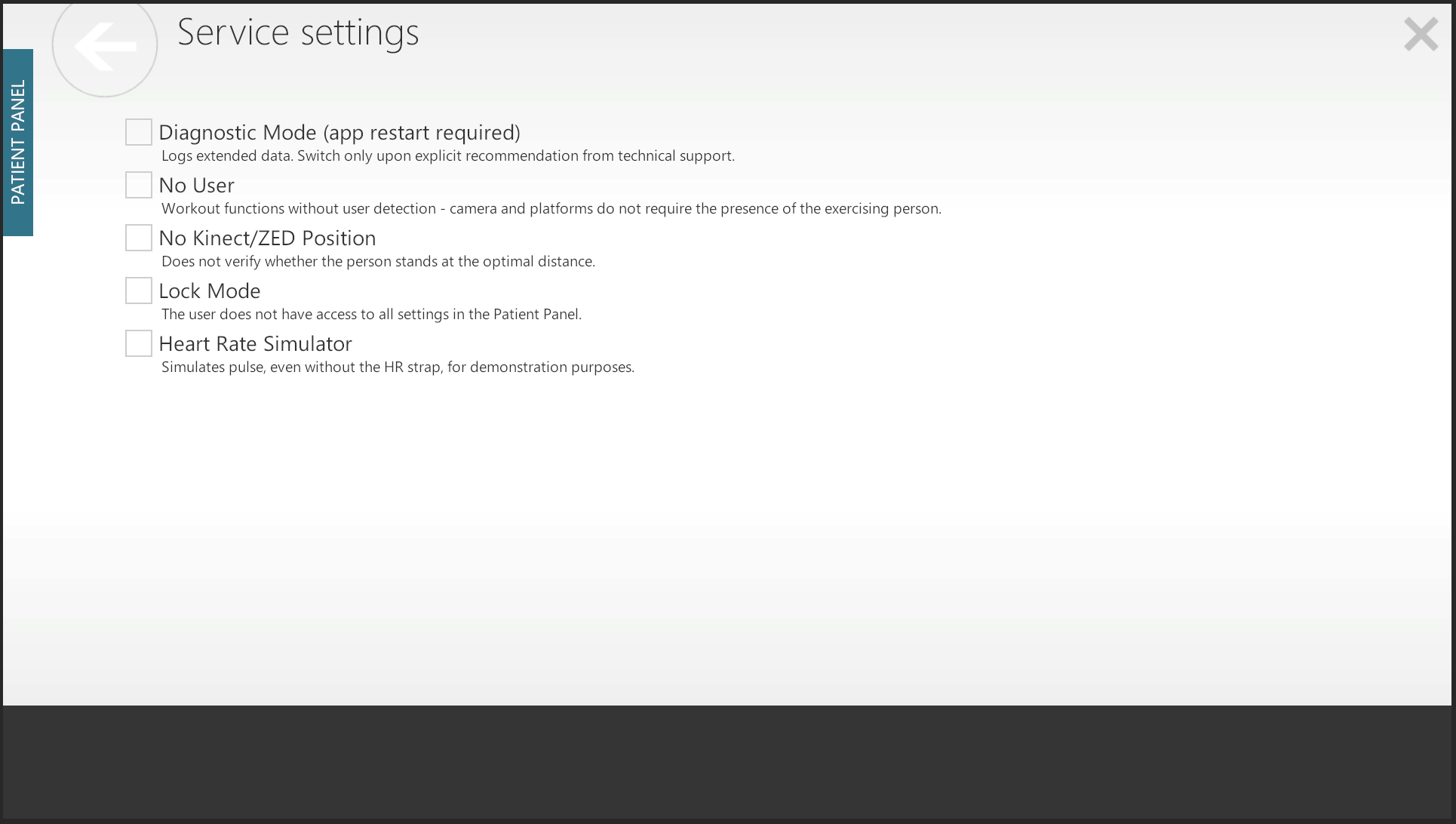Advanced Service Settings Overview for Distributors
Introduction
As a distributor of VAST.Rehab systems, having access to advanced configuration options is essential for effective demonstrations, testing, and technical support. The Service Settings panel offers a set of powerful tools that allow you to simulate user activity, bypass certain system checks, and showcase features without requiring full setup or patient presence.
This guide provides a detailed overview of each service setting, explaining its purpose, recommended use cases, and precautions. Whether you're preparing for a client presentation, conducting internal training, or assisting with troubleshooting, understanding these settings will help you unlock the full potential of the VAST.Rehab platform.

Accessing the Service Settings Panel
To access the Service Settings in VAST.Rehab, start by opening the Patient Panel and navigating to the Settings section. Within this menu, you will find the Service Settings option. Access to this panel is protected by a special password to ensure that only authorized personnel can modify advanced system configurations.
If you are a distributor or technician and require access, please contact our team directly. We will provide the password upon verification and confirmation of your role. This ensures that the system remains secure and that service settings are used appropriately during demonstrations, testing, or support procedures.
Diagnostic Mode
Purpose:
Enables extended system logging for diagnostics and troubleshooting.
Details:
When activated, the system begins collecting more detailed logs about its internal operations, including sensor data, performance metrics, and error traces. This mode is essential for identifying complex issues that cannot be diagnosed through standard logs. The application must be restarted for this mode to take effect.
Use Case:
- Recommended only when instructed by VAST technical support.
- Useful during remote diagnostics or when preparing logs for bug reports.
No User Mode
Purpose:
Allows the system to function without detecting a user.
Details:
Normally, VAST.Rehab uses cameras and sensors to verify the presence of a person before starting exercises. With this mode enabled, the system bypasses this check, allowing exercises to run even if no one is present.
Use Case:
- Ideal for demonstrations, training sessions, or testing exercises without a patient.
- Useful for distributors showcasing the system to potential clients.
No Kinect/ZED Position Verification
Purpose:
Disables the check for optimal user positioning relative to the camera.
Details:
VAST typically ensures that the user stands at a specific distance from the camera (Kinect or ZED) to ensure accurate motion tracking. This setting disables that verification, allowing exercises to proceed regardless of user position.
Use Case:
- Useful in constrained environments where ideal positioning isn't possible.
- Helpful during system setup or when testing camera functionality.

May reduce tracking accuracy if the user is too close or too far from the camera.
Lock Mode
Purpose:
Restricts access to advanced settings in the Patient Panel.
Details:
When enabled, Lock Mode hides or disables certain configuration options that are normally available to pateitns. This ensures that users cannot accidentally modify critical settings.
Use Case:
- Ideal when the system is used by patients independently at home.
- Useful during onboarding or demonstrations to limit access to sensitive configurations.
Heart Rate Simulator
Purpose:
Simulates heart rate data for demonstration purposes.
Details:
This feature generates artificial heart rate signals even when no heart rate strap is connected. It allows the system to display pulse data during mock sessions, making it easier to showcase biofeedback features.
Use Case:
- Ideal for sales presentations and training.
- Allows full demonstration of heart rate-dependent features without requiring a real user.

This is a simulation only and should not be used for clinical decision-making.
Final Notes
These Service Settings are powerful tools that can significantly alter how VAST.Rehab operates. They are intended for use by trained personnel, distributors, or under the guidance of technical support. Misuse of these settings may lead to inaccurate results or compromised safety during therapy sessions.

If you're unsure about any of these options, it's best to contact VAST.Rehab Support before making changes.
Related Articles
How to use VAST.Rehab Sandbox Mode - A Guide for Distributors
Empowering Demonstrations Without Compromising Real Data For our partners and distributors around the world, delivering high-quality demonstrations and training sessions is key to showing the full potential of VAST.Rehab. That’s why we’ve designed ...Windows 24H2 Issues on VAST.Rehab
Windows 10 and Windows 11 version 24H2 have rolled out important security and performance enhancements. However, a recent cumulative update inadvertently removed several critical libraries used by our VAST.Rehab suite. This removal can lead to ...Converting License to enable Integration with Therapist Panel
Introduction: VAST.Rehab Patient Panel is a dedicated application designed for individuals undergoing rehabilitation treatment. By default, the application works in "Home Therapy" mode, allowing patients to perform exercises without direct ...Network Discovery in Windows 10 and 11
Network Discovery is a feature in Windows 10 and 11 that, when turned on, allows your computer to find other computers and devices on the same network and likewise, allows other network users to find your computer. This is a significant element in ...Hardware Requirements for VAST.Rehab
VAST.Rehab is an innovative, fully-featured virtual rehabilitation system designed to facilitate comprehensive and personalized patient treatment. However, to ensure that both healthcare professionals and patients can take full advantage of its ...